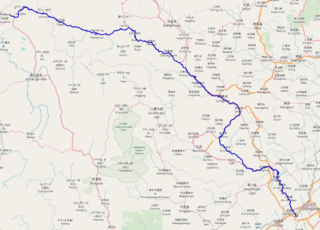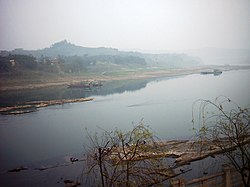
Sichuan is a province in Southwest China occupying most of the Sichuan Basin and the easternmost part of the Tibetan Plateau between the Jinsha River on the west, the Daba Mountains in the north and the Yungui Plateau to the south. Sichuan's capital city is Chengdu. The population of Sichuan stands at 83 million. Sichuan neighbors are Qinghai to the northwest, Gansu to the north, Shaanxi to the northeast, Chongqing to the east, Guizhou to the southeast, Yunnan to the south, and the Tibet Autonomous Region to the west.

The Sichuan Basin, formerly transliterated as the Szechwan Basin, sometimes called the Red Basin, is a lowland region in southwestern China. It is surrounded by mountains on all sides and is drained by the upper Yangtze River and its tributaries. The basin is anchored by Chengdu, the capital of Sichuan province, in the west, and the direct-administered municipality of Chongqing in the east. Due to its relative flatness and fertile soils, it is able to support a population of more than 100 million. In addition to being a dominant geographical feature of the region, the Sichuan Basin also constitutes a cultural sphere that is distinguished by its own unique customs, cuisine and dialects. It is famous for its rice cultivation and is often considered the breadbasket of China. In the 21st century its industrial base is expanding with growth in the high-tech, aerospace, and petroleum industries.


Langzhong is a county-level city in northeastern Sichuan province, China, located on the middle reaches of the Jialing River. It is administered as part of the prefecture-level city of Nanchong. Langzhong has a total population of 880,000, with 250,000 residing in the urban area.

Guangyuan is a prefecture-level city in Sichuan Province, China, bordering the provinces of Shaanxi to the northeast and Gansu to the northwest. The city has a population of 2,305,657 as of the 2020 census.

Longnan is a prefecture-level city in the southeast of Gansu province in China. It borders Sichuan on its south and Shaanxi on its east. As of the 2020 Chinese census, the population of the prefecture-level city was 2,855,555.

Wudu District is a district and the political and cultural centre of Longnan, Gansu province, China. It borders the provinces of Shaanxi and Sichuan to the southeast. It has a population of 590,000, of which 110,000 live in the urban area.

Li County or Lixian is an administrative division of the prefecture-level city of Longnan in southeastern Gansu, a northwestern province of China. The 2010 Chinese census found a population of 458,237, a decline of around 25,000 from the year 2000 but still placing it second in size within its prefecture.
Bikou Town (碧口镇) is a town under Wen County, in Longnan, Gansu. It is located along the Bailong River, just downstream of the Bikou Dam. In 2008 it had a population of 16,901.

The Bailong River or Khuchu, Drukchu is a 576km-long river in the Yangtze River basin. From its source to confluence with the Jialing River, the Bailong is actually longer and is thus the main stem of the Jialing River system. The scenic Jiuzhaigou reserve is found along one of the Bailong's tributaries. Two reservoirs have been constructed in Wen County. The reservoirs serve to provide hydroelectricity, aquaculture, flood control, irrigation and for tourism development.
Qu River is a river of in China's Sichuan Province and Chongqing Municipality. It is a left tributary of the Jialing River, which in its turn is a left tributary of the Yangtze; it is thus part of the East China Sea basin. Its length is 720 km.

Fu River, or Fu Jiang is a river of in China's Sichuan Province and Chongqing Municipality. It is a right tributary of the Jialing River, which in its turn is a left tributary of the Yangtze; it is thus part of the East China Sea basin.

The Daba Mountains, also known by their Chinese name as the Dabashan, are a mountain range in Central China between the watersheds of the Yellow and Yangtze Rivers. Part of the larger Qinling mountain range, it cuts through four provinces: Sichuan, Chongqing, Shaanxi, and Hubei. It is about 1,000 kilometers (620 mi) long.

The Baoji–Chengdu railway or Baocheng railway, is a mixed single- and double-track, electrified, railroad in China between Baoji in Shaanxi province and Chengdu in Sichuan province. The Baocheng Line is the main railway connection between the northern/northwestern and southwestern China. The line has a total length of 668.2 km and passes through mostly mountainous terrain in southern Shaanxi, eastern Gansu and northern Sichuan. It opened in 1961 as the first rail outlet from Sichuan, and in 1975 became the first railway in China to be electrified. Other cities along route include Mianyang, Guangyuan, Guanghan and Lueyang.

Xi'an–Chengdu high-speed railway or Xi'an-Chengdu Passenger Dedicated Line, is a dual-track, electrified, high-speed rail line in Western China between Xi'an and Chengdu, respectively the provincial capitals of Shaanxi and Sichuan. This line, which commenced operations on 6 December 2017, runs 510 km (320 mi) through Shaanxi and Sichuan provinces and accommodates trains traveling at speeds up to 250 km/h (160 mph). Travel time between the two provincial capitals was reduced from 16 to less than three hours.
Shaannan or Southern Shaanxi refers to the portion of China's Shaanxi province south of the Qinling Mountains. Its name derives from the province's abbreviation "Shaan" (陕) combined with the word "Nan", its geographical location within the province.
The name Fu River may refer to several rivers in China:

Lanzhou–Chongqing railway or Lanyu railway is a higher-speed railway in China connecting Lanzhou and Chongqing. Construction started in 2010, last segment of the railway was opened for service in September 2017. The line allows trains to travel between Chongqing and Lanzhou, Gansu via Nanchong and Guangyuan, Sichuan.

















